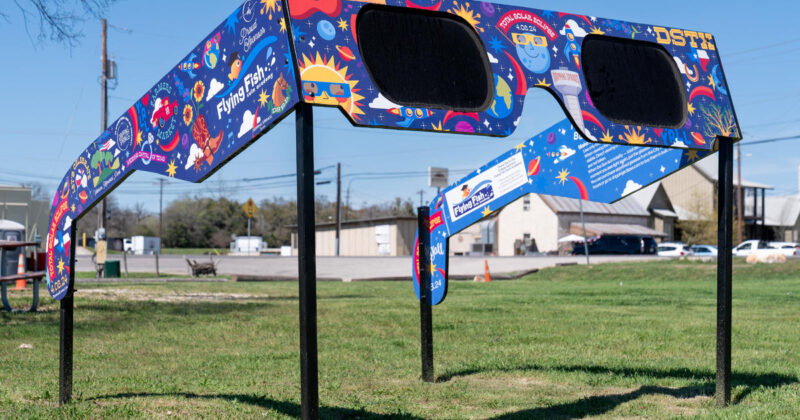Steve Wright said he first heard about the total eclipse on April 8 four years ago, when a visitor booked the first room for the event at Vermont’s Jay Peak Resort. Wright, the resort’s general manager, said he soon started hearing rumblings from other ski areas.
“They said, ‘The hype is real’,” he recalled, adding that he’s never seen anything quite like the visitor excitement over the eclipse.
That early prediction turned out to be prescient, with Wright noting that all of Jay Peak’s 900 rooms have been fully booked for April 7 — at a cost of about $500 per night — for a year and a half. By comparison, the resort had roughly 80 bookings on the same day last year. Roughly 800 rooms are booked for April 8, the day of the eclipse.
Indeed, tourists are getting into the spirit of the rare celestial event, a major boon for local businesses across the eclipse’s direct path.
One couple is getting married at the 4,000 summit of Jay Peak during the eclipse, while the resort will have a Pink Floyd cover band paying “The Dark Side of the Moon” at the base. And with more than a foot of snow forecast to arrive just ahead of the eclipse, skiers are also likely to hit the slopes as the moon and the sun align.
Wright said he expects his resort to book as much revenue over the April 5-8 weekend as it typically would during the entire month of April.
“It has been well advertised that we’re at the end of the path of totality and we will have the best look at the eclipse, at over three and a half minutes,” he told CBS MoneyWatch, adding the event is giving a boost not just to Jay Peak, but to the entire region, a rural part of Vermont that is known for scenic farms and ski areas. “The whole community is sold out.”
The total solar eclipse isn’t just throwing shade across the dozen states in line for the astronomical event — it’s also shining an economic bonanza on states from Texas to Vermont. The eclipse could bring a financial boost of as much as $6 billion, thanks to increased spending on hotels, restaurants and travel, according to an estimate from the Perryman Group, an economic analysis firm.
“It is amazing how much this has captured the imagination,” Ray Perryman, an economist and CEO of the Perryman Group, told CBS MoneyWatch. “It’ll be concentrated in a short period of time, but it does give these cities an opportunity to show themselves off, including the smaller cities.”
The eclipse is likely to jolt local economies partly because of its timing, Perryman noted. Americans have returned to their pre-pandemic travel habits, while the event is occurring in spring, when people are more likely to want to travel than in winter.
“There’s also the fact that we won’t have another eclipse like this for many years,” he said.
Tthe next total solar eclipse visible in the U.S. won’t occur until 2045, according to NASA.
“It’s not only a scientific phenomenon, but an emotional one as well,” Dan Schneiderman, the eclipse partnership coordinator at the Rochester Museum of Science, told CBS News.
Bill Nye and Dark Side Stout
April 8 will bring viewing parties across cities both large and small that lie in the eclipse’s path. Events range from the Eclipse-O-Rama 2024 with science expert Bill Nye in Fredericksburg, Texas, at $325 per ticket, to a NASA-sponsored gathering at the Indianapolis Motor Speedway (a more budget-conscious $20 per ticket.)
Companies also are issuing special commemorative items to draw people to their viewing parties, such as Rohrback Brewing Co. in Rochester, New York (a city in the path of the totality), which is making the Rohrbach Totality Black Lager. Switchback Brewery in Burlington, Vermont — another city that will witness the totality — will release Dark Side Stout for attendees at its April 8 event.
“It’s a great opportunity to market our city, and as a place where people might want to live one day,” Malik Evans, the mayor of Rochester, New York, a Rust Belt city whose fortunes have drifted as once powerful manufacturing companies like Xerox and Eastman Kodak declined, told CBS News.
AirDNA
Texas is forecast to enjoy the biggest economic gains at about $1.4 billion, according to Perryman’s estimates. He said that’s partly due to Texas’ large population and to the number of big cities, like Austin and Dallas, that are in the path of the totality.
Vermont, whose population of 650,000 makes it the second-smallest state in the nation, is expecting as many as 200,000 people to come to the state to witness the eclipse, CBS Boston reported. Its economic boost could reach $230 million, one of the smaller financial impacts for the states in the path of the eclipse, Perryman projected. Still, it’s a significant bump for a state with annual GDP of about $43 billion.
How much do solar eclipse glasses cost?
Americans are also spending on gear to properly watch the eclipse because gazing at the event without eye protection can permanently damage your vision. Sunglasses don’t offer enough shielding to prevent harm to your eyes, either.
Instead, people should buy solar eclipse glasses that have been approved by the American Astronomical Society and adhere to the ISO 12312-2 standard. A six-pack of glasses with this standard can be found at Amazon for about $16, or less than $3 a pair.
But consumers can also pick up eclipse glasses as promotions at various retailers. For instance, Sonic Drive-In is now selling a Blackout Slush Float, with each purchase of the celestial-inspired drink coming with a free pair of eclipse viewing glasses. Eyeglass company Warby Parker is also giving away eclipse-viewing glasses through April 8.
Even though the totality itself will only last a few minutes on April 8, businesses could get a boost all weekend, Perryman noted.
“It’s almost a like a concert that causes people to come into town, but they might do other things and see other things,” he noted. “I’m intrigued by the benefit for the small towns.”



